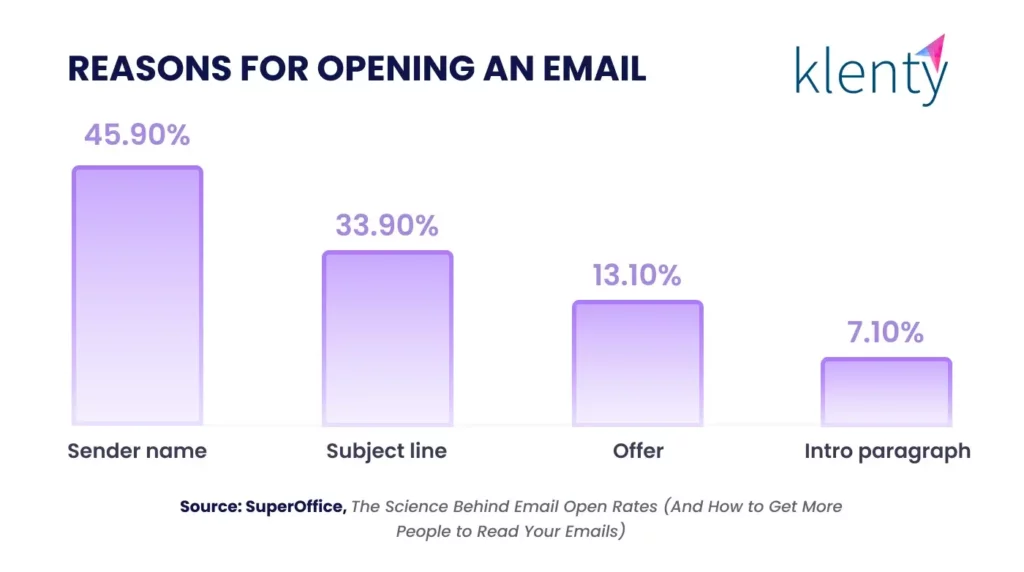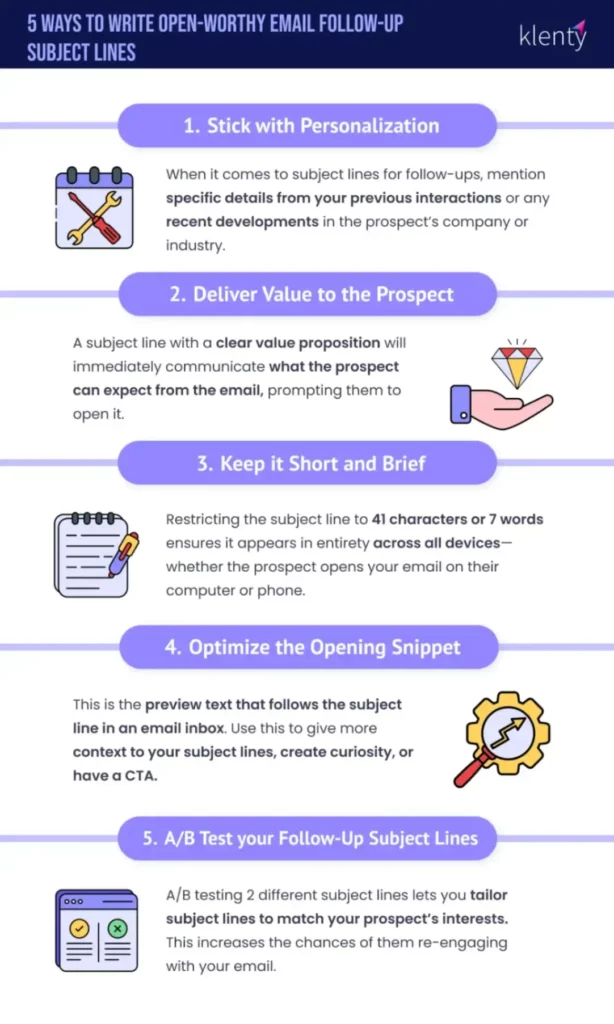When it comes to closing deals, one quality that often pays off is persistence. This is especially true for follow-up emails.
You see, 80% of sales needs an average of 5 persistent follow-ups. That's where the magic happens.
But here's the catch: How do you ensure your follow-up emails grab your prospects' attention amid the sea of messages flooding their inbox?
By crafting irresistible subject lines that they can't ignore.
In this guide, we'll uncover over 60 of the best follow-up email subject lines guaranteed to boost your response rates. Plus, we'll equip you with actionable tips to help you master the art of follow-up email subject lines.
Why Do Follow-up Email Subject Lines Matter?
Your subject line is the key that opens the door to your message. It's the first thing your recipient sees and can be the difference between an opened email and one that gets lost in the inbox.
It's no surprise that a third of your recipients open your email based on the subject line.

In today's bustling digital landscape, your first cold email might not always grab your prospect's attention. This is where follow-up emails come in.
Picture this: The prospect opened your first email during a hectic meeting, glanced at it on the move, or even overlooked it amidst a cluttered inbox. Follow-up emails are your second chance at making an impression, and often, your third, fourth, or fifth too.
65 Follow-up Email Subject Lines To Get More Replies
Your follow-up emails need to not only stand out but also engage and entice your prospects. And a well-crafted subject line will help you pull this off. From attention-grabbing questions to time-tested classics, we'll equip you with effective subject lines for every occasion. Let's look at some subject lines for follow-up email examples:
1. Subject Line for General Follow-Ups
1. It was a pleasure talking to you, [prospect's name]2. It was lovely meeting you, [prospect's name]3. [Prospect's name], I forgot to mention this earlier4. Hi again from [your company]5. [Prospect's name], let's continue our conversationThese subject lines work well when you're shooting a general follow-up email because they're concise, polite, and indicate a continuation of a previous interaction or conversation. They prompt the prospect to open the email to respond or engage further.
2. Value-Driven Subject Lines
6. Personalized tips for [solving pain point]7. Enhance your productivity with [solution]8. [Prospect's name], here's the free [resource] I promised9. A simple way to boost [specific department's] ROI10. Generate 10X ROI with [solution]These value-driven subject lines for follow-up emails focus on what's in it for the recipient. They get right to the point and address their pain points, needs, or desires. When your prospect sees a subject line promising a solution or benefits they're interested in, they're more likely to open the email because it aligns with their current interests.
Plus, these subject lines are straightforward and leave little room for ambiguity. The recipient understands what they can expect from the follow-up email, making them less likely to hesitate before opening it.
3. Mention Mutual Connections/Events
11. [Mutual connection] thought we should connect12. [Prospect's name], do you know [mutual connection]?13. Your network just expanded - Thanks to [mutual connection]14. It was great meeting you at [mutual event]15. What are your views on [mutual event]?When the recipient sees a familiar name or event in the subject line, they are more likely to trust the content and source of the email.
So, if you have a shared experience, connection, or situation that both you and the prospect are aware of, highlight it in your follow-up email subject line. It could be a shared contact, a recent industry conference, or even a relevant news event. This can help boost the trust and credibility factor.
Moreover, these subject lines often pique the recipient's curiosity. They might wonder why you and their mutual connection are reaching out to them. This will drive them to open your follow-up email to find out more.
4. Offer a Compliment
16. I hear you're making waves in [industry/field]!17. Congratulations on [prospect's recent achievement] - impressive!18. Read your blog on [platform] - great insights19. Congratulations! Just saw you got featured on [website]20. You nailed the presentation at [event]If your first email got lost in the prospect's inbox, sprinkle some flattery in your follow-up email subject lines. When a recipient sees a compliment in the subject line, it instantly puts a smile on their face. These positive emotions can nudge them to open the email.
By offering a compliment, you're showing that you've taken the time to learn about the prospect or their achievements. It suggests you're genuinely interested in them and leaves a lasting impression, especially when it is sincere and specific.
5. Subject Line for Follow-up Email After Meeting
21. Key takeaways from our meeting: action items inside22. Next steps after our meeting about [topic]23. Thanks for your time, [prospect's name]24. Summarizing our meeting on [topic]: What's next?25. [Prospect's name], do you have any questions?A follow-up email after a meeting serves as a reminder, helping the prospect recall the context and discussion. It conveys your commitment to the follow-up process, ensuring that important actions or details discussed during the meeting are documented and addressed.
Plus, it lets them know what to expect from the email, whether it's the next steps, a useful resource, or just a quick summary of the meeting.
6. Add Urgency in the Email Follow-up Subject Line
26. [Prospect's name], your exclusive offer expires today27. [Prospect's name], your special access ends soon28. Last 2 days left for [event]. Did you sign up?29. Growth hacks your competitor uses (but you don't)30. Insider tips on how [competitor] improved [specific metric]Subject lines with a dash of urgency are like digital sirens that convey that something important is happening and the recipient needs to stop and pay attention. They prompt them to take action pronto. These subject lines leverage the fear of missing out (FOMO) and communicate that your email contains time-sensitive information or a valuable opportunity.
Moreover, mentioning that their competitor might be ahead of them puts subtle pressure on your prospect. When they see their competitors adopting tactics and tools to outperform them, they might be tempted to take action to avoid losing their competitive edge.
7. Provide a Specified Time
31. Coffee chat? How about [date] at [time]?32. What are you doing on [date]?33. Webinar reminder: Join us on [date] at [time]34. Can we catch up at [time] today?35. How does [day] at [time] sound?Mentioning dates and times in your email subject lines for follow-up adds clarity and urgency to your message. It shows you respect their schedule and are committed to the proposed time.
Moreover, people tend to prioritize actions with deadlines or scheduled appointments. When you specify a date and time, it encourages them to take action promptly, whether it's confirming the meeting, registering for an event, or joining a webinar.
All they need to do is check their calendar for availability and reply with a simple yes or no. If you still don't get a response, you can follow up again to ask what time works for them. This can boost response rates and lead to more successful follow-up interactions.
8. Identify the Decision-makers
36. Can you help me get in touch with [decision maker]?37. Need help finding [prospect's name]38. [Recipient's name], are you the right person to talk about [specific task]?39. Can you help me with this, [recipient's name]?40. Should I stop sending you emails, [recipient's name]?The main challenge in B2B sales is often figuring out who the decision-maker is and how to connect with them. A Gartner study reveals that there can be anywhere between 11 and 20 individual stakeholders involved in a complex B2B purchase. When you're not hearing back, it's likely because you reached out to the wrong person. These subject lines tackle that problem head-on.
By explicitly stating your goal of finding decision-makers or asking for help identifying them, you're showing that you understand the importance of talking to the right people. It also shows that you're not just sending emails for the sake of it; you're actively working to make sure your messages land in the right inbox.
This not only increases your chances of getting a response but also of actually getting in touch with the decision-maker.
9. Add a Touch of Humor
41. [Prospect's name], this email misses you. A lot.42. [Prospect’s name], we're like a bad rom-com43. Don't leave me hanging by this (email) thread44. Time to end this email standoff45. [Prospect's name], we're email friends, right?Who says your subject lines have to be dull and drab? Sprinkling some humor can spice things up in the often serious world of business emails. It shows your human side and makes you more relatable.
A humorous subject line can create a positive impression, making the recipient more likely to engage with your follow-up email. But remember, humor is subjective. So it's a good idea to know your audience and keep it lighthearted without going too far.
10. Last Chance Sales Follow-up Email Subject Line
46. [Prospect's name], this is your last chance at [benefit/opportunity]47. Last chance to save big on [solution]48. Don't miss this - Your exclusive invitation is expiring soon49. This is it: Your last shot at [benefit/opportunity]50. Final reminder: [Benefit] is about to vanish!When you pitch your email as a last chance to nab a benefit, you play on the prospect's FOMO. Plus, these subject lines imply that you have taken the time to reach out again, showing that you're genuinely interested in the prospect. It piques people's curiosity and makes them want to open your email to see what's so special about this supposed "last chance."
11. Friendly Reminder Subject Lines
51. Just a friendly reminder52. I'm waiting to hear your thoughts53. [Prospect's name], let's circle back on our discussion54. Waiting for you to come back55. I'm here to assist you when you're ready
While some persistence is important, you don't want to come off as pushy or make your prospects feel like they're being hassled. That's where these subject lines come in handy—they strike the perfect balance between not being too intrusive and subtly nudging your prospect.
They are polite and remind the prospect about a prior interaction or commitment. By sending a friendly reminder, you show that you value their time and understand that they might be busy. This can help maintain a positive impression even if the prospect has been unresponsive.
12. After Multiple Follow-Ups
56. Are we still a good fit?57. [Prospect's name], what can I do differently?58. It's [your name] again59. Haven't given up on you yet!60. Still interested in [solution]?The trick is to remind the prospect that you've reached out to them before without coming off as too pushy. These subject lines acknowledge your previous communication efforts and gently nudge them to engage with you.
They show your dedication to solving the prospect's problem and prompt them to give your message another chance.
13. Subject Lines With a Call-To-Action
61. [Prospect's name], here are the next steps after the demo62. Register for our [topic] webinar63. Book your meeting for next week (calendar link attached)64. Get started with your trial65. Download your free eBookWhether you're following up with an inbound lead or with a prospect after a meeting, using a CTA-based subject line is a great way to keep the conversation going.
These subject lines don't beat around the bush. They straight up tell the recipient what action you want them to take. No confusion, just clear expectations.
5 Best Practices for Email Follow-up Subject Lines
Crafting compelling follow-up email subject lines is no rocket science. You need to follow the same best practices that you do when writing cold email subject lines.
While the principles remain the same, follow-up subject lines carry a unique weight. As SDRs, your goal is not just to grab attention but to rekindle the interest that dwindled amidst your prospect's overflowing inbox.
Here are some follow-up email subject line best practices that will help you reignite the conversation and boost your open and response rates:

1. Stick With Personalization
Personalized subject lines increase average email open rates by 50%. When crafting initial cold email subject lines, sales reps often put a significant effort into personalization, addressing the prospect by their name, mentioning their company, or referring to specific details from previous conversations or interactions.
However, some might assume that personalization becomes less important in follow-up emails, especially when dealing with leads who haven't responded.
This assumption is a common pitfall. In reality, personalized subject lines remain just as crucial, if not more, in follow-up emails. It can help you improve response rates by 30.5%.
Personalization helps you build and maintain a rapport with the prospect even if they haven't responded to your initial email. Plus, it ensures that your message remains relevant to the prospect's needs and challenges.
When it comes to subject lines for follow-ups, try amping up the personalization by mentioning specific details from your previous interactions or any recent developments in the prospect's company or industry.
2. Deliver Value to the Prospect
Just like your first cold email, your follow-up message should also offer something valuable, informative, or helpful to the recipient. This way, you keep them interested and show them that you're genuinely interested in assisting them.
Instead of coming across as someone who's only after making a sale, you come off as someone who actually cares about their needs.
But make sure you highlight the value proposition in the subject line itself.
This ensures the prospect perceives value in the content you're offering even before they open your email.
For example, subject lines like "Exclusive invitation to [event]" or "Boost [specific function] ROI with these practical tips" immediately communicate what the prospect can expect from the email, prompting them to open it.
Just make sure whatever you're offering matches their needs and interests. This will increase their chances of engaging with your email.
3. Keep It Short and Brief
A whopping 43% of users check emails on their mobile phones. This leaves you with a lot less space before your subject line gets cut off.
Not only this. Short subject lines are easier to read and comprehend at a glance. They capture your prospect's attention quickly and encourage them to open your email.
So, what should be the ideal length of your follow-up email subject line? As a rule of thumb, restricting the subject line to 41 characters or 7 words is a great way to ensure it appears entirely on all devices.
Our own research found that emails with one-word subject lines have an open rate of 34.47%.
Depending on the goal and message of your email, provide enough information in the subject line to pique the prospect's interest without overwhelming them with details.
Top-performing BDR Nanditha Menon keeps her subject lines around 4 to 5 words. "Always talk about them; don't ever talk about what you're offering," she suggests.
4. Optimize the Opening Snippet
The opening snippet is the preview text or preheader that follows the subject line in an email inbox. It's like a sneak peek into what the email is all about. By default, this snippet is the first line of your email.

Source: Litmus
However, you can use cold email tools to personalize this text and add an extra line that isn’t visible when the prospect opens the email.
Emails with this short snippet of text have better open rates (32.95%) than those that don't (25.72%).
You can optimize these snippets by:
- Reinforcing the subject line: Use the opening snippet to reinforce or complement your subject line. Provide some more detail or context to get the prospect intrigued.
- Highlight the value: Emphasize how the prospect stands to benefit from your email. Clearly state why it's worth their while to spend time reading your message.
- Create curiosity: Draft the snippet in a way that piques curiosity without revealing a lot.
- Include a call-to-action: Invite prospects to click for a special offer or to learn more about a particular topic.
- Personalize: Personalize the opening snippet by including the prospect's name or mentioning a previous interaction.
Doing this enhances the chances of your follow-up email standing out in the prospect's inbox and encourages them to open and engage with it. This can help you drive responses and action.
5. A/B Test Your Follow-up Subject Lines
Follow-up emails often compete with your prospects growing inboxes. A/B testing helps you experiment with different subject lines to see which ones really catch your prospects' eyes.
When you send a series of emails, your prospects may show varying degrees of interest in them. A/B testing empowers you to tailor the subject lines to match their interest and understand what really clicks with them. This increases their chances of reengaging with your email.
Plus, this little exercise alone can drive up your ROI to 28%.
How Klenty Helps You With Your Follow-up Emails
Your follow-up emails are more than just digital breadcrumbs. They're an opportunity to reignite interest, address objections, and drive your prospects closer to a positive outcome. Whether you're nurturing existing leads or rekindling cold prospects, these subject lines will help you boost email open rates and response rates.
In addition to subject lines, you need a strategic approach to your follow-up emails to scale your email outreach efforts and boost your email response rates. This is where a sales engagement platform like Klenty can help you.
Klenty's Cadence Playbooks further simplifies email follow-ups at scale. It identifies where your leads are in their buying journey and uses advanced technologies to help you execute the best strategy for every prospecting outcome. Plus, it automatically transfers promising prospects to AEs without any manual intervention.
And that's not all. Klenty's AI Cadences take this up a notch by helping you craft entire sales email sequences in under 2 minutes. With this powerful tool, you can save 5+ hours every week on follow-up creation.
Curious to know more about how Klenty helps you meet your email outreach goals? Book a demo now!
FAQs
1. What should the subject of my follow-up email be?
1. It was lovely meeting you, [prospect's name]
2. Personalized tips for [solving pain point]
3. [Prospect's name], here are the next steps
4. [Prospect's name], let's circle back on our discussion

